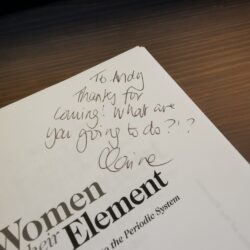What is the gender and ethnic balance of the science stories I write?
In February 2020, Irish chemist Claire Murray provoked me. She spoke clearly and passionately at one of the last professional meetings I went to that was unaffected by lockdowns and social distancing. It launched a book called ‘Women in Their Element’, telling the often-overlooked stories of female scientists involved in filling in the periodic table of chemical elements. And it has changed how I work ever since.
In her talk Claire went beyond recapping her chapter, jointly written with Jess Wade, the pioneering activist on gender bias in science, on discoverers of the superheavy elements at the bottom of the periodic table. She also revealed the biases that have prevented women from being as successful in science as they should be. These include sexism, harassment, and stereotypes that women shouldn’t be scientists. Altogether this leads to a ‘leaky pipeline’, where fewer female scientists progress to more senior levels than male ones. Similar leaky pipeline issues also face Black, Asian and other ethnic minority scientists.
“We have allowed science to be the lone male white genius for too long,” Claire said. She ended by challenging us. “What can we do?” she asked. “How can we measure change? Who is responsible?” and finally, “What are you going to do?” When Claire signed my copy of the book, she repeated that provocation. “What are you going to do?”, she wrote.
[…]
